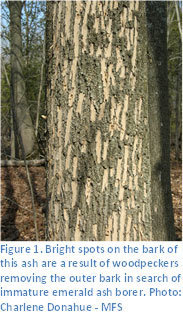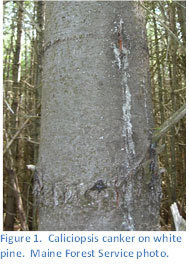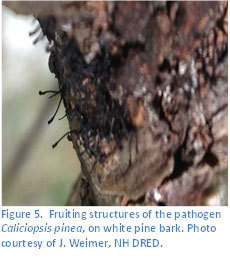Insect & Disease Conditions Update
The 2014 field season
will be coming to a close soon, with the most serious threats from both native
and introduced pests currently held at bay or under close monitoring. With a few notable exceptions detailed below,
the forest resource overall is quite healthy as winter approaches. The spring and summer months have been cool,
with ample moisture well-distributed throughout the season over most regions of
the state.
This
is the final issue of our Conditions Report for the 2014 season. We appreciate your continued vigilance in
keeping our forest resources productive and healthy. The fall season is
on-track to be a spectacular one, so enjoy and have a safe and comfortable
winter.
Ash Spider Mites (Tetranychus
homorus) –For
only the second time in the 22 years I have been at the MFS Insect &
Disease Laboratory a call came in about ash spider mites. In 2010 the report
was from Strong, Franklin County and this year it was from Bath, Sagadahoc
County. The spider mites web over the ash trees so that it looks like the tree
is wrapped in cellophane. The leaves are not covered but silk tubes ran from
one branch to another with red frass or insects under some of the webbing. The mites feed on the leaves during the
summer apparently doing little damage and then move to the trunk to
overwinter. This webbing is not a common
sight anywhere although the mites are reported to live throughout the United
States. Cooler summers and rain may keep the phenomenon from occurring most
years.
 Asian Longhorned Beetle (Anoplophora
glabripennis) – Asian longhorned beetle has not been detected in Maine. This is a good time of year to
be on the lookout for damage. Frass
accumulation should still be visible, and adult beetles would be out until a
killing frost. Also, as you put wood up
for winter, be on the lookout for the large larvae (see photo) and tunneling
within the heart of your maple, birch and other hardwood firewood (but not oak
or ash). You can see photos of the
damage at:
http://www.maine.gov/dacf/php/caps/ALB/ALBdamagepics.shtml
Lab and forest inventory
staff has conducted limited visual surveys for Asian Longhorned Beetle damage
in Westbrook (Cumberland County) and Bath (Sagadahoc County).This work is
funded in part by Cooperative Agricultural Pest Survey through USDA APHIS. Surveys are planned for four additional
communities.
|
Elongate Hemlock Scale (Fiorinia
externa) – Elongate hemlock
scale was reported at three new sites by a landscape professional in southern
Maine this summer, in the towns of Ogunquit, Kennebunkport and Wells (York
County). In some cases it is obvious the
infestations originated from infested planted trees. In others, it is not clear whether the
infestation is part of an expansion of the distribution of this insect through
natural spread. To date, we have only
confirmed forest infestations of elongate hemlock scale in Kittery. However, this is a very cryptic insect. In Ogunquit the insect was seen on balsam
fir, hemlock, concolor fir and blue spruce.
This is the first time the pest has been noted on species other than Abies and Tsuga in Maine, although in the literature it is reported on a wide
range of conifer hosts. In order to see
elongate hemlock scale, one must look at the undersides of the needles of the host trees (or all sides in the
case of spruce!).
 Emerald Ash Borer (Agrilus planipennis) – No emerald ash borers (EAB) have
been found in Maine to date. We continue to monitor for this invasive insect using
purple traps, girdled trees, Cerceris
wasps and outreach efforts to the public. Traps are currently being taken down
and checked.
You can help monitor for EAB by keeping an eye
out for excessive woodpecker feeding on ash this fall and winter. Beginning in late fall, woodpeckers will seek
out the fat pre-pupae of the EAB beneath the bark of infested trees. The immature insects are either in the bark
or the outer sapwood of the tree.
Excavation by woodpeckers creates bright-spots in the otherwise drab
outer bark of targeted trees. It is most
obvious from November through leaf-out. This feeding damage has brought human
attention to several recent detections of EAB such as those in Concord and
Louden NH, and the one in North Andover, MA.
|
Fall Webworm (Hyphantria cunea) – The webs made by
fall webworm larvae are apparent now throughout Maine in relatively low numbers
except way downeast where reports from the Calais area indicate high numbers of
them. Also light trap catches from that area were far higher than normal. Fall webworms are commonly found on ash,
apple, cherry and birch, but you can find them on other hardwoods as well. Since the larvae feed so late in the season,
they do little damage to the health of the tree and primarily are an aesthetic
problem.
Hemlock Woolly Adelgid (Adelges tsugae) – Hemlock
woolly adelgid was recognized by a tourist and confirmed by local arborists in
Camden (Knox County) last month. To date
it has been confirmed on two properties and three trees in an area north of the
downtown. Additional surveys are planned
to determine if it is more widespread. If
you’ll be spending time in hemlocks within about 100 miles of the coast this
fall and winter, take some time to look for adelgid. Bear in mind that you do have to look for it
if you want to catch it early—by the time it is visible through a casual walk
through the woods it is well established.
Oak
Twig Pruner (Anelaphus parallelus) – Damage was obvious from this pest in many parts of
the state this year—we had calls from Bridgton and Peaks Island (Cumberland
County); Farmington (Franklin County); Damariscotta (Lincoln County); Abbot
(Piscataquis County) and Buxton (York County).
This species takes two years to mature—so chances are if you saw a lot
of evidence on your woodlot last year, you didn’t see much this year. In their second
season of feeding the larvae make pruning cuts beneath the bark. They cut around
the branch except for the thin bark so that the branches break with the wind
and fall to the ground. Sometimes the branches are noted when they are dangling
in the crown—a spray of reddened, withered leaves. Others, people notice the fallen twigs and
note the fine workmanship of the cut (and sometimes even note the frass or the
larva itself). The larvae pupate within
the twig in the fall. Many winters they are insulated by a warm blanket of
snow. Adults emerge the following
spring. Interestingly as we looked back over the Lab records of the last 20
years all but one of the oak twig pruner reports were in even numbered years.
Saddled
prominent/green striped mapleworm/variable oakleaf caterpillar complex (Heterocampa
guttivitta, Dryocampa rubicunda,
Lochmaeus manteo and others) – The
saddled prominent complex of hardwood defoliators are native species of
caterpillars that tend to occur together.
The white-blotched heterocampa (Heterocampa umbrata) seems to be
a common part of the mix again this year. These are late-season defoliators and
as such do little damage to the trees. The trees are already beginning to shut
down by August and have enough resources to withstand defoliation this time of
year. Readers and other clientele have
noted noticeable but minor defoliation, caterpillars and frass (especially on
decks!) in western and southern Maine this year. There were a couple reports of
caterpillars ‘raining down from the trees’ but little associated
defoliation. Aerial surveys did not pick
up any noticeable areas of defoliation.
Spruce Budworm (Choristoneura
fumiferana) – The spruce budworm outbreak in Quebec continues to expand and
Maine has ramped up monitoring efforts in the State. Field staff have been on
the lookout for signs of spruce budworm feeding, light traps catches are
checked for budworm and aerial surveys monitor remote regions. But the largest
increase in monitoring has come in pheromone trap use. Eighteen landowners/managers
across the northern half of the state plus Maine Forest Service personnel and
Public Land managers have set traps in almost all of the 400 northern
townships. Pheromone traps have a lure based on the female spruce budworm moth
scent that draws the male moths to the trap. It is a very sensitive method of
trapping insects and the MFS has been doing it since the early 1990’s in 60-85
locations. The trap catches are just starting to come in and look as was
expected: catches are on the rise but not exponentially so. Where there were
traps in the past they are averaging twice what was caught last year. New traps
are providing a baseline for future years. We will continue to closely monitor
this native pest of spruce/ fir forests.
White Pine Cone Borer (Eucosma tocullionana) –
White pine cone borer was noted by a reader in northwestern Waldo County. Brown cones were seen in the crowns and on
the ground under affected pines. Affected
cones were also collected in Casco, Cumberland County. The larvae of this pest (caterpillars) hollow
out the cone while feeding on seeds and scales.
In late summer, holes are visible along the length of infested
cones. Cones affected by this pest can
reach full-length, so the damage may not be immediately obvious. This is a native pest of pine; its feeding
will reduce seed production. It is
generally a minor pest, but look closely at the quality of the pine cones if
you are planning a regeneration cut based on the size of the cone crop.
General Hardwood Conditions – As the summer draws to a close, it seems apparent
that there is considerable variation in forest conditions around the
state. Hardwood species, particularly
the oaks, have rebounded well from the heavy anthracnose and frost damage
experienced in 2013. Hardwood foliage
and overall crown health appear to be quite good, and should provide a great
fall foliage season.
General Conifer Conditions – The conifer resource, however, continues to suffer
from some more serious and chronic disease occurrences. The hard pines (native red pine and several
exotic species such as Austrian, Scotch and Mugo pines) continue to show
substantial damage from the shoot blight diseases Diplodia pinea and Sirococcus
conigenus. New and significant
mortality from S. conigenus was
detected this year in red pine plantations in Chase Stream Township. White pine needle loss due to the white pine
needle disease complex of several needle pathogens was again heavy this year,
especially in the western and southwestern regions of the state. The current white pine needle disease
outbreak has now been documented in many Maine stands for at least eight
consecutive years. Some stands have been
severely affected, and are apparently subject to additional secondary stress
agents, including insects such as the red turpentine beetle (Dendroctonus valens) and pathogens (see
the discussion of Caliciopsis canker,
below). Northern regions had a
considerably drier summer than other regions of the state. However, higher-than-average monthly moisture
conditions occurred throughout the season in most regions of the state,
particularly throughout the range of white pine. Therefore, we expect again to see another
year of heavy needle loss of white pines in 2015.
Caliciopsis pinea Survey – Caliciopsis pinea has been previously
thought to be a secondary pathogen of white pine primarily in overstocked
stands, and in young, pole-sized stands on intermediate or poor sites. The disease is typically identified by pitch
bleeding and streaking in the intermodal regions of the stem. Fresh pitching appears as white streaks. As the canker ages, the pitch usually darkens
and sometimes gives affected stems a blackened or sooty appearance. The cankers are usually fairly superficial,
and may be calloused over within a year or two if tree growth conditions
improve. The resulting cankers can
result in grade losses to wood products. |
|
 |
 While
the disease has been known to occasionally occur in Maine stands, Caliciopsis canker has been recognized
as causing some significant stand damage in New Hampshire over the past several
years. Concern that the disease may be
increasing in occurrence and intensity has led to a cooperative survey project
with the USDA Forest Service, Maine Forest Service, and New Hampshire Dept.
Resources and Economic Development,
Division of Forests and Lands. A survey
for the occurrence and level of damage resulting from Caliciopsis canker in regional white pine stands was initiated this
summer, and will continue for the next two years. To date in Maine, twenty randomly selected
stands have been surveyed, with Caliciopsis
pinea identified on white pine regeneration from 16 stands surveyed. Caliciopsis
symptoms in overstory trees were also identified in 16 stands, but not always
from those with infected white pine regeneration. Relationships between tree stress resulting
from the white pine needle disease complex, and the incidence and severity of Caliciopsis canker have not been
established, but may become apparent as studies continue.
|
New Christmas Tree Pest Manual: A third, revised edition of the USDA Forest Service Christmas Tree Pest Manual has been
published. This manual has proven
extremely useful in the past, and is designed to help identify and control
damaging pests of Christmas trees in the Northeastern and North Central regions
of the United States. The third edition
includes several new pest problems, and has a greater emphasis on pests of firs
than past editions have covered. To receive
a printed copy, contact Doreen Deutsch at ddeutsch@fs.fed.us or
call 651-649-5244. The publication is also available at: http://www.na.fs.fed.us/pubs/2014/Christmas%20Tree%20Pest%20Manual%203rd%20Edition.pdf
Tar Leaf Spot (Rhytisma
acerinum) - The Lab has received several samples of tar leaf spot again
this year. Tar leaf spot is a relatively
benign, but very conspicuous affliction of maples this time of year. The leaf disease is most severe on Norway
maples, but occasionally other maple species are affected. This year, the leaf spot is considerably less
severe than it has been in recent past years.
For more information on tar leaf spot, see: http://www.maine.gov/dacf/mfs/forest_health/diseases/tar_leaf_spot_on_norway_maple.htm
Conditions Report No. 4, 2014
On-line: http://maine.gov/dacf/mfs/publications/condition_reports.html
Department
of Agriculture Conservation & Forestry
Maine Forest Service - Forest
Health and Monitoring
Contributors:
Charlene Donahue, Allison Kanoti, William Ostrofsky
|